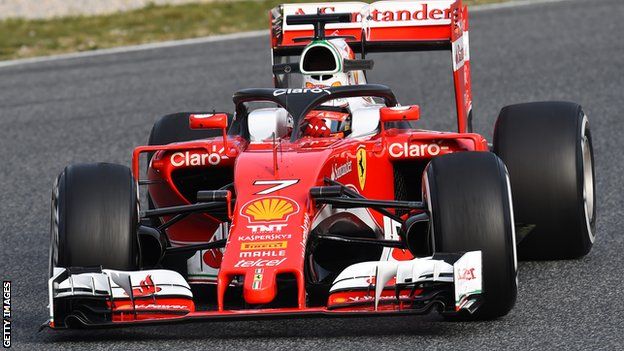Formula 1: 'Halo' protection agreed for 2017
- Published

Kimi Raikkonen testing the 'halo' earlier this year
Formula 1 is to introduce the 'halo' driver head protection device in 2017.
Technical chiefs decided the device, which forms a protective structure in front of and above a driver's head, is the more ready of the two options.
But work will continue on the 'aeroscreen' championed by Red Bull with a view to introducing it in 2018.
A modified version of the 'halo', which was first run by Ferrari pre-season, will be tested in June before a planned final agreement in July.
This is said to be a more elegant solution than the design tested in Spain in February.
It is made of titanium rather than steel and the central hub where the forward and side arms intersect is smaller.
Red Bull test new 'aeroscreen'
The decision to postpone the 'aeroscreen', which had greater support because of what were agreed to be its more elegant aesthetics, was made because it suffered an unexpectedly poor performance in its most recent test.
It has also not yet been tested in a form that provides enough free head space for the driver - a concept that takes into account how much a driver's head might move in an accident and seeks to ensure there is nothing within that area that it can hit hard in a crash.
The halo is the preferred design of two options available...
Red Bull's 'aeroscreen' design could be an alternative, but is behind in development
The 'aeroscreen' is regarded to have added advantages because the windscreen aspect adds increased protection, but it brings with it potential disadvantages in terms of visibility that have yet to be resolved.
Governing body the FIA is confident the problems can be overcome but it had promised teams a final decision on the device to be used in 2017 by the end of June so felt it had no option but to press on with 'halo two', as it is known.
The 'halo' also requires further testing but no major issues are expected.
It still has to go through the official legislative process before it is formally adopted, starting with the strategy group of leading teams, the FIA and F1 commercial boss Bernie Ecclestone.
The FIA does have the option of forcing it through on safety grounds, but this is not expected to be necessary as all parties are in agreement that a device will be adopted.
- Published21 May 2016
- Published26 May 2016
- Published26 May 2016
- Published25 May 2016
- Published24 May 2016
- Published15 May 2016
- Published23 May 2016
- Published24 May 2016
- Published23 May 2016
- Published18 December 2015
- Published2 November 2018
- Published13 May 2016
- Published26 February 2019